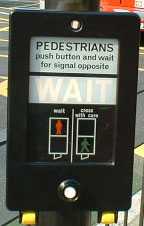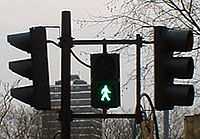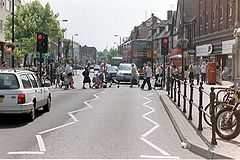Pelican crossing


A Pelican crossing is a type of pedestrian crossing featuring a pair of poles each with a standard set of traffic lights facing oncoming traffic, a push button and two illuminated, coloured pictograms facing the pedestrian from across the road - a red, stationary person to indicate that it is not safe to cross, and a green, walking person to indicate that it is safe to do so.
Details

The name is derived from PELICON, a portmanteau of pedestrian light controlled. The term Pelican crossing originated in the United Kingdom, but similar traffic control devices are in use throughout the world. The term is also used in the Republic of Ireland.
The pelican crossing was a relatively minor development of the X-way crossing. This earlier crossing was largely identical to the pelican crossing, but instead of a green light for motorists, featured a white diagonal cross. The intention of this was to distinguish the crossing lights from any nearby junction (standard) traffic lights). The white cross was widely criticised and users and motoring organisations alike called for the white cross to be replaced by a green light. With some changes to the light timings and road markings, the X-way crossing became the pelican crossing.
The Pelican crossing was the first definitive light controlled crossing for pedestrians in the UK, introduced in 1969, after the earlier failed experiment of the panda crossing. Previously only zebra crossings had been used, which have warning signals (Belisha beacons), but no control signals. The pedestrian lights are situated on the far side of the road to the pedestrian. A puffin crossing has the lights on the same side as the pedestrian; a toucan crossing is a crossing for pedestrians and bicycles; a pegasus crossing allows horse-riders to cross as well.
Additionally, a Pelican crossing, as distinct from a puffin crossing, has the special feature that while the green man flashes to indicate that pedestrians may continue crossing but may not start to cross, the red light changes to an amber flashing light permitting cars to pass if there are no further pedestrians. This reduces the delay to traffic. Also, Pelican crossings can be used to enforce local speed limits by detecting the approach speed of the traffic, and setting the traffic lights to red if a speeding violation is detected. This has been found to significantly reduce the incidence of speeding in residential areas.
In UK law, Pelican crossings which go straight across the road are one crossing, even when there is a central island, therefore traffic must wait for pedestrians who are crossing from the other side of the island. This rule is different from similar standard pedestrian crossings where each portion of the crossing is treated as a separate crossing. However, at installations where the crossings that cross each carriageway are separate crossings, then they are staggered.
Internationally
In Hong Kong where control panels are also used as in the United Kingdom, no zig-zag lines are marked. At some crossings the traffic signals still turn to red but at much longer intervals.
A HAWK beacon, used experimentally in the United States with a standard pedestrian crossing signal, stops traffic when a pedestrian pushes a button to cross, but goes dark unless activated.
See also
References
- The History of British Roadsigns, Dept. for Transport, 2nd Edition, 1999.
External links
- BBC article, on the introduction of Panda crossings, and subsequent developments.